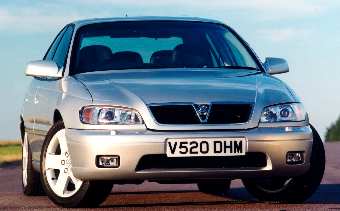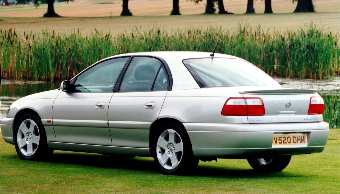
|
|
| Opel / Vauxhall Omega - by Brian G. Thornton - September 1999 | |
| Brian Thornton, freelance journalist and our Road Test Editor reports on his drive of the MY2000 Opel / Vauxhall Omega. Photographs provided by Vauxhall. Brian may be contacted by email. This week Brian also writes his experiences from the passenger seat of Austin McHale's Toyota Corolla WRC. Click here for that story. | |
|
The revised Opel/Vauxhall Omega due next month will have a new 144PS 2.2-litre petrol engine already used in the Frontera. For a further 12 months the 2.0-litre engine continues to be available at entry level. There is a new bonnet, bumpers and boot, front and rear lights, standard front and side airbags, active front seat head restraints, 10-year anti-perforation warranty, intelligent dual-zone climate control, load protection for estate models, sports chassis for MV6 and the DSA chassis further refined in a �100 million sterling investment. |

|
|
Opel's designers and engineers have revised the Omega so that more than a third of the car's components have been changed, with 3,000 of the 8,000 individual parts redesigned or modified. From next spring a combined audio and Siemens satellite-aided navigation system will become available, and a "Smart" airbag detects passenger seat occupancy. New to Omega's engine range is a 2.2-litre, four-valve 106kW/144PS petrol power plant that complements the 100kW/136PS 2.0-litre unit. Two counter-rotating balancer shafts eliminate most driveline-related vibration and noise. Omega has a drive-by-wire electronic accelerator pedal. Its movements are detected by a sensor and translated into action by an electric motor. This technology should produce more precise response to pedal movement, although a teething problem on my test car, which may be solved by laptop re-programming, meant extra throttle was needed giving something of a grand prix start away from the lights! |
|

|
The 2.5-litre BMW 96kW/130 bhp engine continues - its advantage is a huge 250 Nm of torque at 2200 revs, and a projected 36mpg on average. The Siemens satellite navigation was a demo version only. It frequently left me wondering which of two turns in close proximity should be taken, and ultimately I followed it up a one-way street the wrong way! |
|
Omega has CARE and ALIAS put together by Andon with Poka Yoke! Among the most important quality assurance tools in the Omega production process is the Andon monitoring system. This is based on the principle that workers can stop the assembly line at any time if they detect a fault. Production only resumes after the fault has been analysed and rectified. A similar function is found in Poka Yoke, a process from Japan that reliably helps avoid faults in the development phase and in the layout of the production process. On the production line in Russelsheim, for example, a comprehensive network of cameras can identify surfaces, read codes or determine fluid quantities. If deviations from the norm are detected, production is stopped until the source of the fault is found and eliminated. Every car on the Omega production line is subjected to the CARE process (Customer Acceptance Review and Evaluation), which monitors quality specifications for each successive stage of production in the body shop, paint shop, interior equipment and finishing areas. The new Omega estate is equipped with the innovative Additional Load Intrusion Avoidance System (ALIAS) which gives greater passenger protection against loads and baggage sliding forwards in a frontal collision and significantly reduces the forward motion of the centre rear-seat passenger in this type of incident. |
|
|
ALIAS consists of a locking mechanism that securely links the two folding rear seat backs at the partitioning point to form a sturdy barrier. A bolt at the top of the rear seat backs makes locking and unlocking quick and easy. Both front seats feature new active head restraints, first introduced by Saab, an Opel sister company. In a rear impact, they significantly reduce the risk of whiplash-related injuries. The restraints are activated by the front seat occupant's body pressing against the seat back after a rear-end collision. Moving upwards and forwards, the restraints reduce the gap between the head and the head restraint so that the strain on the cervical vertebrae is lessened. |

|
|
The mechanism is integrated into the upper front seat back and weighs only about 1 kg (2.2 lbs). It does not impair the side airbag located lower down in the seat back or detract from occupant comfort. Its mechanism is also fully reversible. If, for example, in a multiple collision, the passenger's body is jerked backwards and forwards several times in rapid succession, the head restraints are re-set and ready to cushion the head on every impact. They do not need to be replaced after an accident. From next spring, an airbag system will be available with seat occupancy recognition for the front passenger seat. A sensor in the seat surface detects whether the passenger seat is occupied. If it is, the front and side airbags on the passenger side are automatically activated. When the seat is empty the airbags are de-activated and will not be released in an accident. Prices and specifications will be announced when the cars reach showrooms at the end of October. Technical specifications can be obtained here. |
|
| [This Week] [Full Contents] [News] [Features] [Car of the Week] [Motorsport] [A-Z] |